Amana AFI2539ERM User Manual
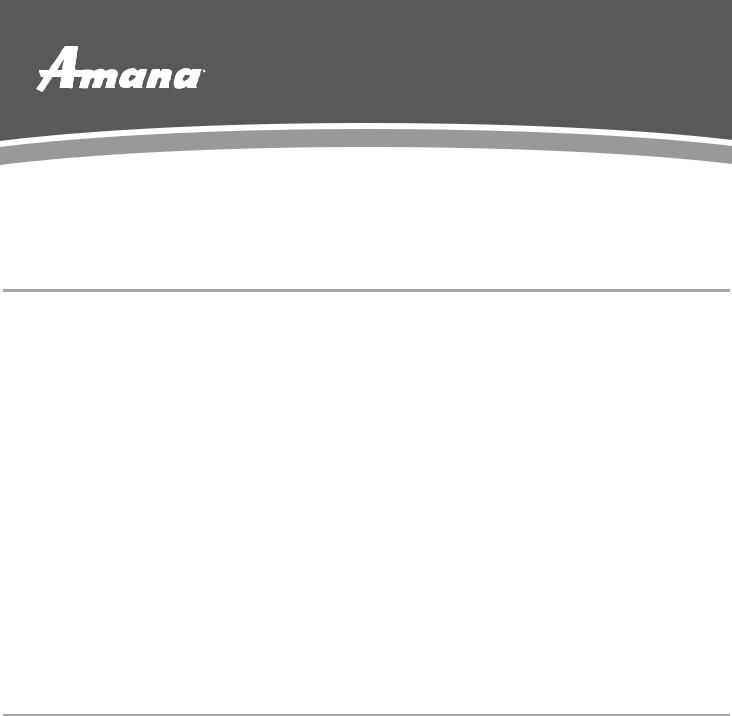
REFRIGERATOR USER INSTRUCTIONS
THANK YOU for purchasing this high-quality product. Register your new refrigerator at www.amana.com. In Canada, register your refrigerator at www.amanacanada.ca.
For future reference, please make a note of your product model and serial numbers. These can be located on the inside wall of the refrigerator compartment.
Model Number __________________________________________________ |
Serial Number __________________________________________________ |
Table of Contents / Table des matières
REFRIGERATOR SAFETY ............................................................. |
2 |
INSTALLATION INSTRUCTIONS .................................................. |
3 |
Unpack the Refrigerator............................................................... |
3 |
Location Requirements ................................................................ |
3 |
Electrical Requirements ............................................................... |
4 |
Water Supply Requirements ........................................................ |
4 |
Connect the Water Supply........................................................... |
4 |
Refrigerator Doors and Drawer.................................................... |
5 |
Adjust the Doors........................................................................... |
8 |
REFRIGERATOR USE .................................................................... |
8 |
Opening and Closing Doors......................................................... |
8 |
Using the Controls........................................................................ |
8 |
Crisper Humidity Control............................................................ |
10 |
Ice Maker and Ice Storage Bin................................................... |
10 |
Water and Ice Dispensers .......................................................... |
10 |
Water Filtration System.............................................................. |
11 |
REFRIGERATOR CARE ............................................................... |
12 |
Cleaning...................................................................................... |
12 |
Changing the Light Bulb ............................................................ |
12 |
TROUBLESHOOTING .................................................................. |
13 |
Refrigerator Operation................................................................ |
13 |
Temperature and Moisture......................................................... |
14 |
Ice and Water ............................................................................. |
14 |
PERFORMANCE DATA SHEET................................................... |
16 |
WARRANTY ................................................................................. |
17 |
SÉCURITÉ DU RÉFRIGÉRATEUR ....................................... |
19 |
INSTRUCTIONS D’INSTALLATION ..................................... |
20 |
Déballage du réfrigérateur................................................... |
20 |
Exigences d'emplacement.................................................. |
21 |
Spécifications électriques ................................................... |
21 |
Spécifications de l’alimentation en eau .............................. |
21 |
Raccordement de la canalisation d'eau ............................. |
22 |
Portes et tiroir du réfrigérateur ............................................ |
23 |
Ajustement des portes ........................................................ |
26 |
UTILISATION DU RÉFRIGÉRATEUR................................... |
26 |
Ouverture et fermeture des portes...................................... |
26 |
Utilisation des commandes................................................. |
26 |
Réglage de l'humidité dans le bac à légumes.................... |
28 |
Machine à glaçons et bac d’entreposage .......................... |
28 |
Distributeurs d’eau et de glaçons ....................................... |
29 |
Système de filtration de l'eau.............................................. |
30 |
ENTRETIEN DU RÉFRIGÉRATEUR ..................................... |
31 |
Nettoyage ............................................................................ |
31 |
Remplacement de l’ampoule d’éclairage ........................... |
32 |
DÉPANNAGE ......................................................................... |
32 |
Fonctionnement du réfrigérateur ........................................ |
32 |
Température et humidité..................................................... |
33 |
Glaçons et eau .................................................................... |
33 |
FEUILLE DE DONNÉES SUR LA PERFORMANCE ............ |
35 |
GARANTIE .......................................................................... |
36 |
W10800827A
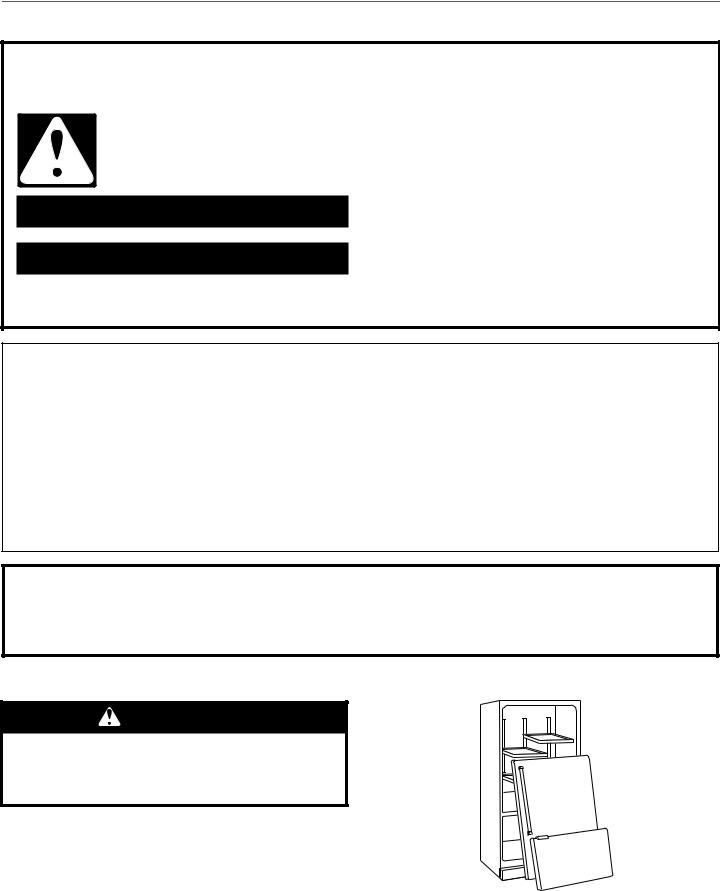
REFRIGERATOR SAFETY
Your safety and the safety of others are very important.
We have provided many important safety messages in this manual and on your appliance. Always read and obey all safety messages.
This is the safety alert symbol.
This symbol alerts you to potential hazards that can kill or hurt you and others.
All safety messages will follow the safety alert symbol and either the word “DANGER” or “WARNING.” These words mean:
 DANGER
DANGER
 WARNING
WARNING
You can be killed or seriously injured if you don't immediately follow instructions.
You can be killed or seriously injured if you don't follow instructions.
All safety messages will tell you what the potential hazard is, tell you how to reduce the chance of injury, and tell you what can happen if the instructions are not followed.
IMPORTANT SAFETY INSTRUCTIONS
WARNING: To reduce the risk of fire, electric shock, or injury when using your refrigerator, follow these basic precautions:
■ Plug into a grounded 3 prong outlet. |
■ Use nonflammable cleaner. |
|
■ Do not remove ground prong. |
■ Keep flammable materials and vapors, such as gasoline, |
|
■ Do not use an adapter. |
away from refrigerator. |
|
■ Use two or more people to move and install refrigerator. |
||
■ Do not use an extension cord. |
||
■ Disconnect power before installing ice maker (on ice maker |
||
■ Disconnect power before servicing. |
||
kit ready models only). |
||
■ Replace all parts and panels before operating. |
||
■ Use a sturdy glass when dispensing ice (on some models). |
||
■ Remove doors from your old refrigerator. |
||
■ Do not hit the refrigerator glass doors (on some models). |
||
|
SAVE THESE INSTRUCTIONS
State of California Proposition 65 Warnings:
WARNING: This product contains one or more chemicals known to the State of California to cause cancer.
WARNING: This product contains one or more chemicals known to the State of California to cause birth defects or other reproductive harm.
Proper Disposal of Your Old Refrigerator ■ Leave the shelves in place so that children may not easily climb inside.
WARNING
Suffocation Hazard
Remove doors from your old refrigerator.
Failure to do so can result in death or brain damage.
IMPORTANT: Child entrapment and suffocation are not problems of the past. Junked or abandoned refrigerators are still dangerous
– even if they will sit for “just a few days.” If you are getting rid of your old refrigerator, please follow these instructions to help prevent accidents.
Before You Throw Away Your Old Refrigerator or Freezer:
■Take off the doors.
2
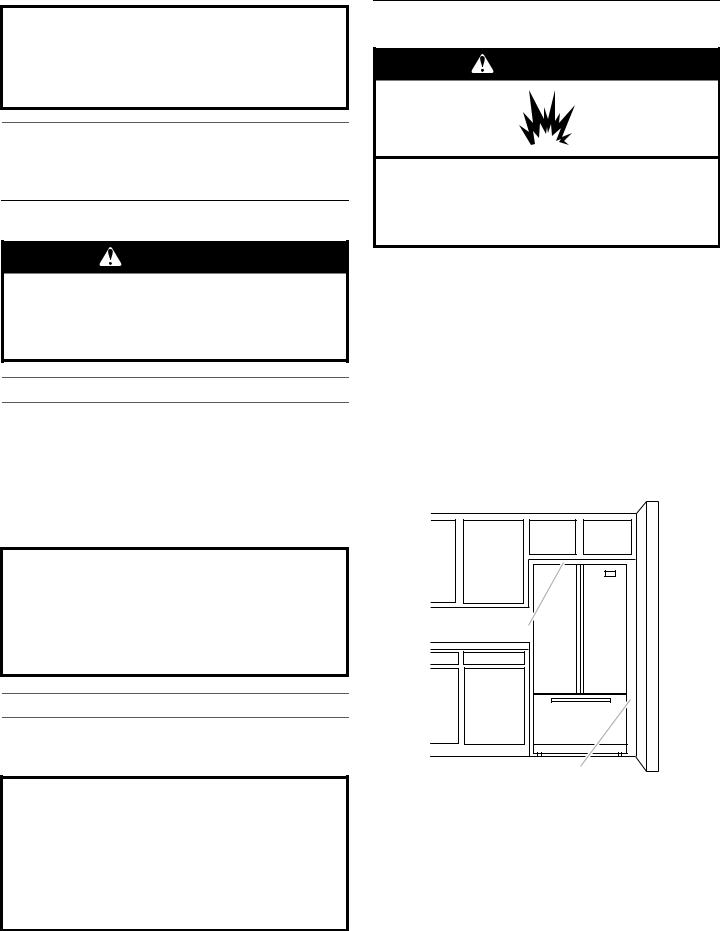
Important information to know about disposal of refrigerants:
Dispose of refrigerator in accordance with Federal and Local regulations. Refrigerants must be evacuated by a licensed, EPA certified refrigerant technician in accordance with established procedures.
INSTALLATION
INSTRUCTIONS
Unpack the Refrigerator
WARNING
Excessive Weight Hazard
Use two or more people to move and install refrigerator.
Failure to do so can result in back or other injury.
Remove the Packaging
■Remove tape and glue residue from surfaces before turning on the refrigerator. Rub a small amount of liquid dish soap over the adhesive with your fingers. Wipe with warm water and dry.
■Do not use sharp instruments, rubbing alcohol, flammable fluids, or abrasive cleaners to remove tape or glue. These products can damage the surface of your refrigerator. For more information, see “Refrigerator Safety.”
■Dispose of/recycle all packaging materials.
When Moving Your Refrigerator:
Your refrigerator is heavy. When moving the refrigerator for cleaning or service, be sure to cover the floor with cardboard or hardboard to avoid floor damage. Always pull the refrigerator straight out when moving it. Do not wiggle or “walk” the refrigerator when trying to move it, as floor damage could occur.
Clean Before Using
After you remove all of the packaging materials, clean the inside of your refrigerator before using it. See the cleaning instructions in “Refrigerator Care.”
Important information to know about glass shelves and covers:
Do not clean glass shelves or covers with warm water when they are cold. Shelves and covers may break if exposed to sudden temperature changes or impact, such as bumping. Tempered glass is designed to shatter into many small, pebble-size pieces. This is normal. Glass shelves and covers are heavy. Use both hands when removing them to avoid dropping.
Location Requirements
WARNING
Explosion Hazard
Keep flammable materials and vapors, such as gasoline, away from refrigerator.
Failure to do so can result in death, explosion, or fire.
IMPORTANT: This refrigerator is designed for indoor, household use only.
To ensure proper ventilation for your refrigerator, allow for a ¹⁄ " (1.25 cm) of space on each side and at the top. Allow for a 1" (2.54 cm) space behind the refrigerator. If your refrigerator has an ice maker, allow extra space at the back for the water line connections. When installing your refrigerator next to a fixed wall, leave a 3³⁄ " (9.5 cm) minimum space between the refrigerator and wall to allow the door to swing open.
NOTE: This refrigerator is intended for use in a location where the temperature ranges from a minimum of 55°F (13°C) to a maximum of 110°F (43°C). The preferred room temperature range for optimum performance, which reduces electricity usage and provides superior cooling, is between 60°F (15°C) and 90°F (32°C). It is recommended that you do not install the refrigerator near a heat source, such as an oven or radiator.
¹⁄ " (1.25 cm)
3³⁄ " (9.5 cm)
3
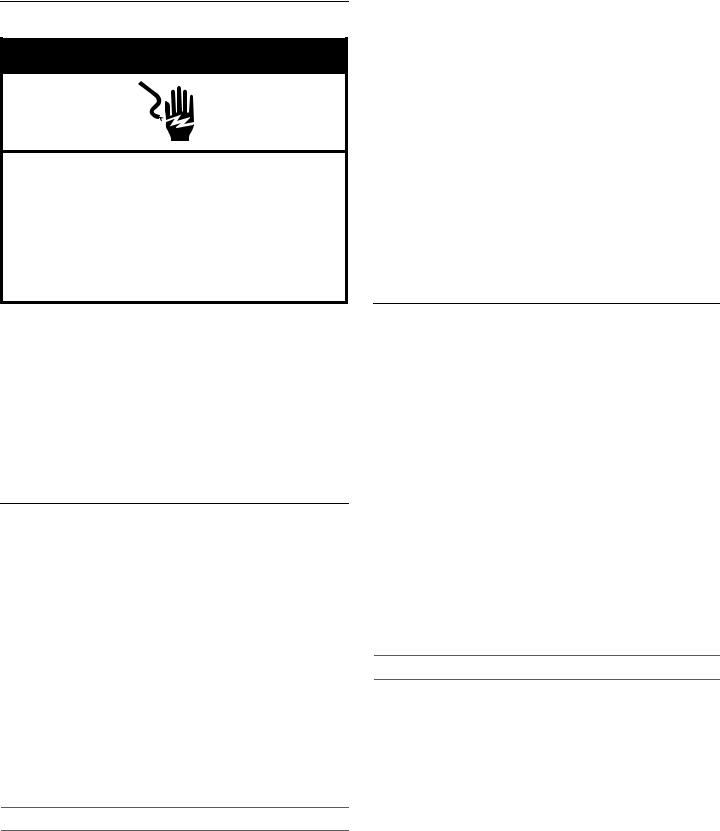
Electrical Requirements
 WARNING
WARNING
Electrical Shock Hazard
Plug into a grounded 3 prong outlet.
Do not remove ground prong.
Do not use an adapter.
Do not use an extension cord.
Failure to follow these instructions can result in death, fire, or electrical shock.
Before you move your refrigerator into its final location, it is important to make sure you have the proper electrical connection.
Recommended Grounding Method
A 115 volt, 60 Hz, AC only 15or 20-amp fused, grounded electrical supply is required. It is recommended that a separate circuit serving only your refrigerator and approved accessories be provided. Use an outlet that cannot be turned off by a switch. Do not use an extension cord.
NOTE: Before performing any type of installation, cleaning, or removing a light bulb, turn OFF Cooling, and then disconnect the refrigerator from the electrical source. When you have finished, reconnect the refrigerator to the electrical source and turn ON Cooling. See “Using the Controls.”
Water Supply Requirements
Gather the required tools and parts before starting installation. Read and follow the instructions provided with any tools listed here.
TOOLS NEEDED: |
|
|
|
■ |
Flat-blade screwdriver |
■ |
¹⁄ " Nut driver |
■ |
⁄ " and ¹⁄ " Open-end or two |
■ |
¹⁄ " Drill bit |
|
adjustable wrenches |
■ |
Cordless drill |
|
|
||
IMPORTANT:
■All installations must meet local plumbing code requirements.
■Do not use a piercing-type or ³⁄ " (4.76 mm) saddle valve which reduces water flow and clogs more easily.
■Use copper tubing and check for leaks. Install copper tubing only in areas where the household temperatures will remain above freezing.
■For models with water filters, the disposable water filter should be replaced at least every 6 months.
Water Pressure
A cold water supply with water pressure between 35 and 120 psi (241 and 827 kPa) is required to operate the water dispenser and ice maker. If you have questions about your water pressure, call a licensed, qualified plumber.
Reverse Osmosis Water Supply
IMPORTANT: The pressure of the water supply coming out of a reverse osmosis system going to the water inlet valve of the refrigerator needs to be between 35 and 120 psi (241 and
827 kPa).
If a reverse osmosis water filtration system is connected to your cold water supply, the water pressure to the reverse osmosis system needs to be a minimum of 40 to 60 psi (276 to 414 kPa).
If the water pressure to the reverse osmosis system is less than 40 to 60 psi (276 to 414 kPa):
■Check to see whether the sediment filter in the reverse osmosis system is blocked. Replace the filter if necessary.
■Allow the storage tank on the reverse osmosis system to refill after heavy usage.
■If your refrigerator has a water filter, it may further reduce the water pressure when used in conjunction with a reverse osmosis system. Remove the water filter. See “Water Filtration System.”
If you have questions about your water pressure, call a licensed, qualified plumber.
Connect the Water Supply
Read all directions before you begin.
IMPORTANT:
■Plumbing shall be installed in accordance with the International Plumbing Code and any local codes and ordinances.
■The gray water tubing on the back of the refrigerator (which is used to connect to the household water line) is a PEX (cross-linked polyethylene) tube. Copper and PEX tubing connections from the household water line to the refrigerator are acceptable and will help avoid off-taste or odor in your ice or water. Check for leaks.
If PEX tubing is used instead of copper, we recommend the following Whirlpool Part Numbers:
W10505928RP (7 ft [2.14 m] jacketed PEX), 8212547RP (5 ft [1.52 m] PEX), or W10267701RP (25 ft [7.62 m] PEX).
■Install tubing only in areas where temperatures will remain above freezing.
■If you turn on the refrigerator before the water line is connected, turn off the ice maker to avoid excessive noise or damage to the water valve.
Connect to Water Line
1.Unplug refrigerator or disconnect power.
2.Turn OFF main water supply. Turn ON nearest faucet long enough to clear line of water.
3.Find a ¹⁄ " to 1¹⁄ " (12.7 mm to 31.8 mm) vertical cold water pipe near the refrigerator.
IMPORTANT:
■Make sure it is a cold water pipe.
■Horizontal pipe will work, but the following procedure must be followed: Drill on the top side of the pipe, not the bottom. This will help keep water away from the drill. This also keeps normal sediment from collecting in the valve.
4.Determine the length of copper tubing you need. Measure from the connection on the lower right rear of the refrigerator to the water pipe. Add 7 ft (2.1 m) to allow for cleaning. Use ¹⁄ " (6.35 mm) O.D. (outside diameter) copper tubing. Be sure both ends of copper tubing are cut square.
4
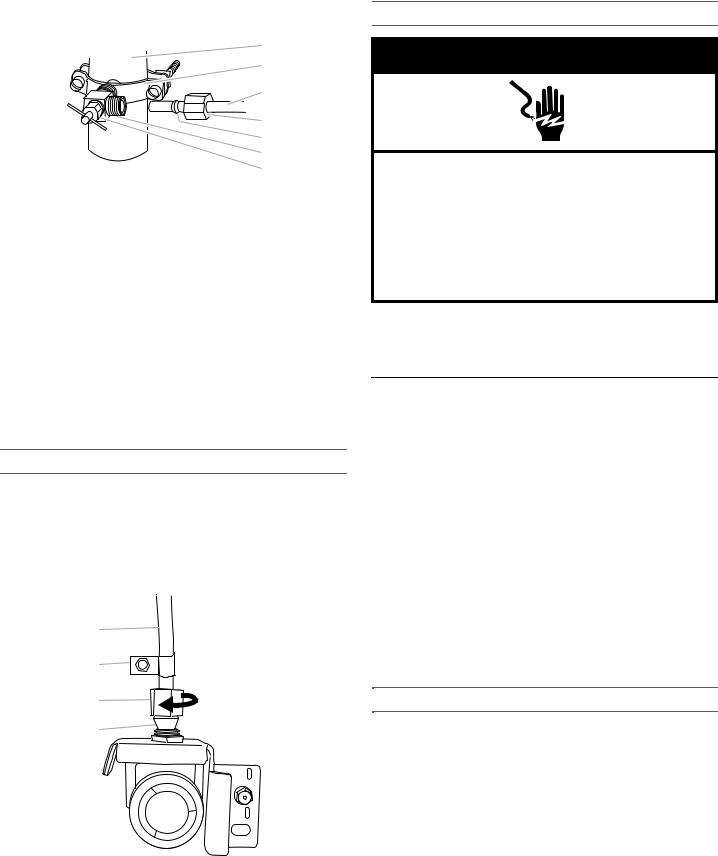
5.Using a cordless drill, drill a ¹⁄ " hole in the cold water pipe you have selected.
|
A |
|
B |
|
C |
|
D |
|
E |
|
F |
|
G |
A. Cold water pipe |
E. Compression sleeve |
B. Pipe clamp |
F. Shutoff valve |
C. Copper tubing |
G. Packing nut |
D.Compression nut
6.Fasten the shutoff valve to the cold water pipe with the pipe clamp. Be sure the outlet end is solidly in the ¹⁄ " drilled hole in the water pipe and that the washer is under the pipe clamp. Tighten the packing nut. Tighten the pipe clamp screws slowly and evenly so the washer makes a watertight seal. Do not overtighten.
7.Slip the compression sleeve and compression nut on the copper tubing as shown. Insert the end of the tubing into the outlet end squarely as far as it will go. Screw compression nut onto outlet end with adjustable wrench. Do not overtighten, or you may crush the copper tubing.
8.Place the free end of the tubing in a container or sink, and turn ON the main water supply. Flush the tubing until water is clear. Turn OFF the shutoff valve on the water pipe.
Connect to Refrigerator
1.Remove plastic cap from water valve inlet port. Attach the copper tube to the valve inlet using a compression nut and sleeve as shown. Tighten the compression nut. Do not overtighten. Confirm copper tubing is secure by pulling on copper tubing.
2.Create a service loop with the copper tubing. Avoid kinks when coiling the copper tubing. Secure copper tubing to refrigerator cabinet with a “P” clamp.
A
B
C
D
A. Copper tubing |
C. Compression nut |
B. “P” clamp |
D. Compression sleeve |
3.Turn on water supply to refrigerator and check for leaks. Correct any leaks.
Complete the Installation
 WARNING
WARNING
Electrical Shock Hazard
Plug into a grounded 3 prong outlet.
Do not remove ground prong.
Do not use an adapter.
Do not use an extension cord.
Failure to follow these instructions can result in death, fire, or electrical shock.
1. Plug into a grounded 3 prong outlet.
NOTE: Allow 24 hours to produce the first batch of ice. Discard the first three batches of ice produced. Allow 3 days to completely fill the ice container.
Refrigerator Doors and Drawer
All graphics referenced in the following instructions are included later in this section after “Final Steps.”
TOOLS NEEDED: ⁄ ", ³⁄ ", ¹⁄ " hex-head socket wrench, #2 Phillips screwdriver, and a flat-blade screwdriver.
IMPORTANT:
■Your refrigerator may have a standard reversible refrigerator door with either a freezer door or freezer drawer, or French doors. Follow the instructions specific to the door style of your model.
■All graphics referenced in the following instructions are included later in this section after “Final Steps.” The graphics shown for the standard door are for a right-hand swing refrigerator (hinges factory installed on the right).
■If you only want to remove and replace the doors, see “Remove Door(s) and Hinges” and “Replace Door(s) and Hinges.”
■Before you begin, turn the refrigerator control OFF, and remove food and adjustable door or utility bins from the doors.
Remove and Replace Handles
Style 1 Handles
■Using a 3/32" or 1⁄ " hex key, loosen the two setscrews located on the side of each handle. Pull the handle straight out from the door. Make sure you keep the screws for reattaching the handles. See Style 1 Handle, graphic 1.
■To replace the handles, reverse the directions.
Style 2 Handles
To Remove Handles:
1.Grasp the lower part of the handle firmly, slide the handle up and pull the handle straight out from the door. See Handle graphic.
5
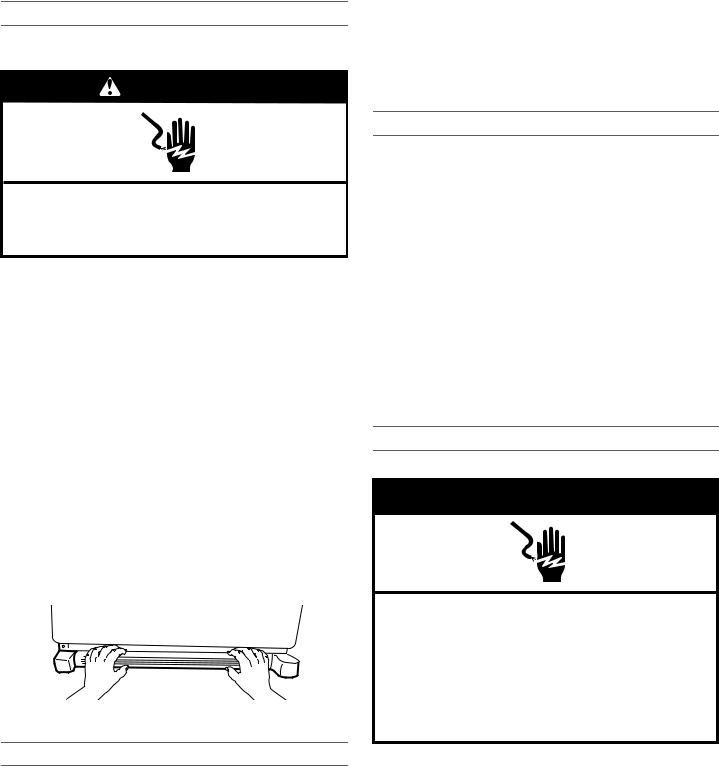
To Replace Handles:
1.Position the handle so that the large holes in the mounting clips are down and align the holes with the door studs.
2.Rotate the handle so that the mounting clips are flat against the door and slide the handle down to engage. See Handle graphic.
Remove Doors and Hinges
IMPORTANT: Remove food and any adjustable door or utility bins from doors.
WARNING
Hazard
Disconnect power before removing doors.
Failure to do so can result in death or electrical shock.
1.Unplug refrigerator or disconnect power.
2.Keep the refrigerator doors closed until you are ready to lift them free from the cabinet.
NOTE: Provide additional support for the refrigerator door while the hinges are being removed. Do not depend on the door gasket magnets to hold the door in place while you are working
3.Starting with the right-hand side door, remove the parts for the top hinge as shown in Top Hinge graphic. Lift the refrigerator door from the bottom hinge pin.
4.Remove top hinge cover from left side refrigerator door.
5.Disconnect the wiring plug located on top of the hinge by wedging a flat-blade screwdriver or your fingernail between the two sections. See Connections graphic.
6.Disconnect the water line by pulling back on the locking collar while pulling the water line out of the water line connector. See Connections graphic.
7.Remove the parts for the top hinge as shown in Top Hinge graphic. Lift the left-hand side door from the bottom hinge pin.
8.Remove the base grille. Grasp the grille firmly and pull it toward you.
9.Using a ³⁄" hex wrench, remove the leveling leg brackets from the bottom of the cabinet. Keep screws for later use.
Replace Doors and Hinges
1.Assemble the parts for the top hinge as shown in Top Hinge graphic. Do not tighten the screws completely.
2.Replace the parts for the bottom hinge as shown in Bottom Hinge graphic. Tighten screws. Replace the refrigerator door.
NOTE: Provide additional support for the refrigerator door while the hinges are being moved. Do not depend on the door gasket magnets to hold the door in place while you are working.
3.Align the door so that the bottom of the refrigerator door aligns evenly with the top of the freezer drawer. Tighten all screws.
4.Reconnect the wiring plug on top of the left-hand side refrigerator door.
5.Reconnect the water line by pulling back the locking collar ring while firmly pushing the water line into the connector.
6.Check for leaks. Replace the top hinge covers.
Remove and Replace Freezer Drawer
IMPORTANT: Two people may be required to remove and replace the freezer drawer. Graphics are included later in this section.
Remove Drawer Front
1.Open the freezer drawer to full extension.
2.Loosen the four screws attaching the drawer glides to the drawer front. See Drawer Front Removal graphic.
NOTE: Loosen screws three to four turns. Keep the screws in the drawer front.
3.Lift drawer front upward and off the screws. See Drawer Front Removal graphic.
Replace Drawer Front
1.Slide the drawer glides out of the freezer compartment. Insert the screws in the top of the drawer front into the slots in the drawer brackets. See Drawer Front Replacement graphic.
2.Pull the drawer brackets toward you to position the two screws in the bottom of the drawer front into the brackets. See Drawer Front Replacement graphic.
3.Completely tighten the four screws.
Final Steps
1. Replace the base grille.
 WARNING
WARNING
Electrical Shock Hazard
Plug into a grounded 3 prong outlet.
Do not remove ground prong.
Do not use an adapter.
Do not use an extension cord.
Failure to follow these instructions can result in death, fire, or electrical shock.
2.Plug into a grounded 3 prong outlet.
3.Return all removable parts to doors and drawer and food to refrigerator and freezer.
6
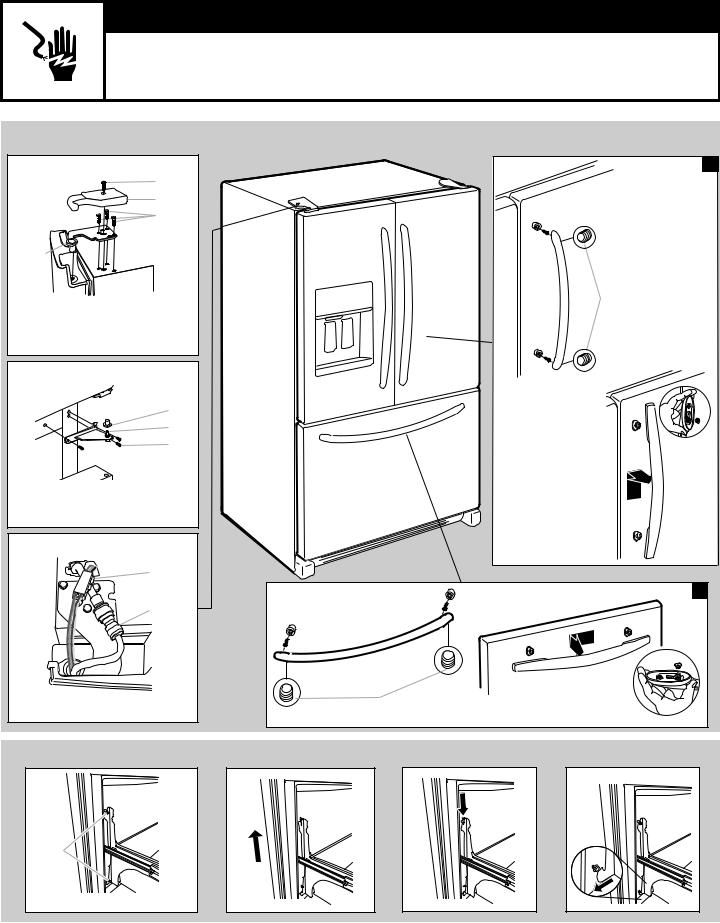
 WARNING
WARNING
Electrical Shock Hazard
Disconnect power before removing doors.
Failure to do so can result in death or electrical shock.
Door Removal & Replacement
Top Hinges
A
B
C |
D 
A.Hinge Cover Screw
B.Top Hinge Cover
C.5/16" Hex-Head Hinge Screws
D.Top Hinge
Bottom Hinges |
A |
B |
C |
A. Hinge Pin Cover |
B. Bottom Hinge |
C. Hinge Screws |
Connections |
A |
B |
A.Wiring Plug
B.Water Line Connection
1
Style 1 - Handle
A
A. 3/32" Setscrew
Style 2 - Handle
Style 1 - Handle |
Style 2 - Handle |
2 |
A |
|
|
A. 3/32" Setscrew |
|
|
Drawer Front Removal |
Drawer Front Replacement |
A
A. Loosen 4 Door Bracket Screws
7
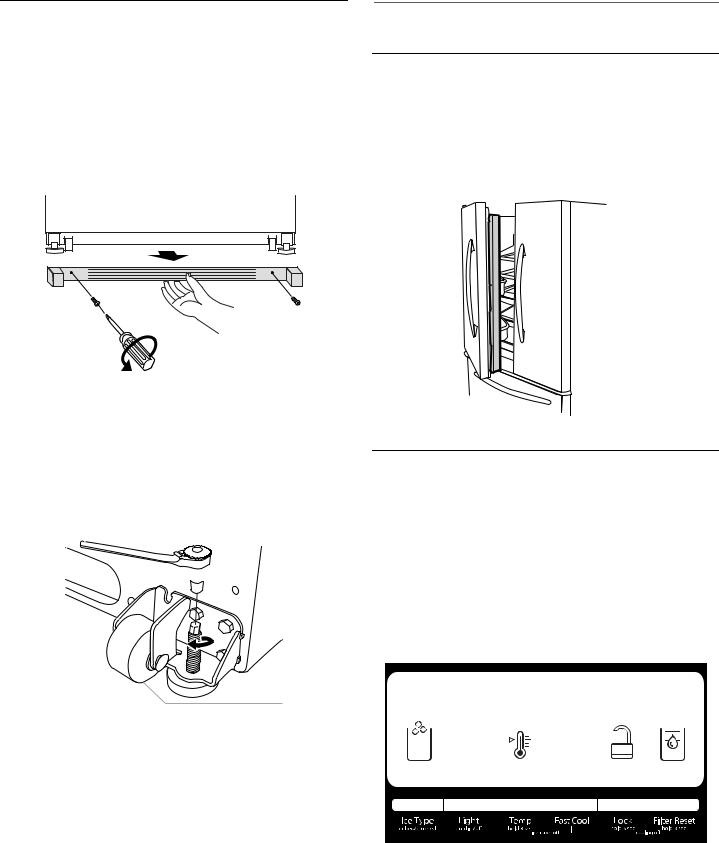
Adjust the Doors
IMPORTANT:
■Your refrigerator has two adjustable, front leveling screws – one on each side of the refrigerator base. If your refrigerator seems unsteady or you want the door to close easier, use the instructions below.
■Before moving the refrigerator, raise the leveling screws so the front rollers are touching the floor.
1.Remove the two screws fastening the base grille to the cabinet, and set the screws aside. Grasp the grille and pull it toward you.
REFRIGERATOR USE
Opening and Closing Doors
There are two refrigerator compartment doors. The doors can be opened and closed either separately or together.
There is a vertically-hinged seal on the left refrigerator door.
■When the left-hand refrigerator door is opened, the hinged seal automatically folds inward so that it is out of the way.
■When both doors are closed, the hinged seal automatically forms a seal between the two doors.
2.Raise or lower the cabinet.
Using a ¹⁄" hex driver, turn the leveling screw on each side to raise or lower that side of the refrigerator.
NOTE: Having someone push against the top of the refrigerator takes some weight off the leveling screws. This makes it easier to turn the screws. It may take several turns of the leveling screw to adjust the tilt of the refrigerator.
■ To raise, turn the leveling screw clockwise.
 A
A
A. Hinged seal
Using the Controls
The refrigerator and freezer controls are located on the dispenser panel.
■To lower, turn the leveling screw counterclockwise. IMPORTANT: The display screen on the dispenser control panel
 ¹⁄"
¹⁄"
 A
A
B
A.Leveling screw
B.Front roller
3.Open the door again to make sure that it closes as easily as you like. If not, tilt the refrigerator slightly more to the rear by turning both leveling screws clockwise. It may take several more turns, and you should turn both screws the same amount.
4.Replace the base grille.
will turn off automatically and enter “sleep” mode when the control buttons and dispenser levers have not been used for 2 minutes or more. While in “sleep” mode, the first press of a control button will only reactivate the display screen, without
changing any settings. After reactivation, changes to any settings can then be made. If no changes are made within 2 minutes, the display will re-enter “sleep” mode.
■Touch any control button on the dispenser panel to activate the display screen. The home screen will appear as shown.
8

Adjusting the Controls
For your convenience, your refrigerator and freezer controls are preset at the factory. When you first install your refrigerator, make sure that the controls are still set to the “mid-settings.” The factory recommended set points are 38°F (3°C) for the refrigerator and 0°F (-18°C) for the freezer.
IMPORTANT:
■Wait 24 hours before you put food into the refrigerator. If you add food before the refrigerator has cooled completely, your food may spoil.
NOTE: Adjusting the set points to a colder than recommended setting will not cool the compartments any faster.
■If the temperature is too warm or too cold in the refrigerator or freezer, first check the air vents to be sure they are not blocked before adjusting the controls.
■The preset temperatures should be correct for normal household usage. The controls are set correctly when milk or juice is as cold as you like and when ice cream is firm.
■Wait at least 24 hours between adjustments. Recheck the temperatures before other adjustments are made.
To view and adjust the set points, press and hold the TEMP button for 3 seconds. When adjust mode is activated, adjusting information will appear on the display screen.
NOTE: To view Celsius temperatures, press the LIGHT button when adjust mode is activated. To return the display setting to Fahrenheit, press LIGHT again.
■When adjust mode is activated, the display screen shows the refrigerator set point and “FRIDGE” appears.
■Press LOCK to raise the set point, or press FAST COOL to lower the set point.
■When you have finished viewing (and adjusting if desired) the refrigerator set point, press TEMP to change the display to show the freezer set point. When the zone has been changed, “FREEZER” appears on the display screen.
■Press LOCK to raise the set point, or press FAST COOL to lower the set point.
■When you have finished viewing (and adjusting if desired) both the refrigerator and freezer set points, press FILTER to save the settings.
NOTE: To exit without saving changes, press ICE TYPE at any time while in adjust mode, or allow about 60 seconds of inactivity and adjust mode will turn off automatically.
When adjusting temperature set points, use the following chart as a guide.
CONDITION: |
TEMPERATURE |
|
ADJUSTMENT: |
|
|
REFRIGERATOR too cold |
REFRIGERATOR Setting |
|
1° higher |
|
|
REFRIGERATOR too warm |
REFRIGERATOR Setting |
|
1° lower |
|
|
FREEZER too cold |
FREEZER Setting |
|
1° higher |
|
|
FREEZER too warm / |
FREEZER Setting |
Too little ice |
1° lower |
|
|
The set point range for the refrigerator is 33°F to 45°F (0°C to 7°C). The set point range for the freezer is -5°F to 5°F (-21°C to -15°C).
Cooling On/Off
Your refrigerator and freezer will not cool when cooling is turned off.
■To turn cooling off, press and hold the LOCK and FILTER buttons at the same time for 3 seconds. When cooling is off, “COOLING OFF” will appear on the display screen.
IMPORTANT: To avoid unintentionally locking the dispenser or changing other settings, be sure to press both buttons at exactly the same time.
A
A. Press Lock and Filter Reset at the same time.
Press and hold LOCK and FILTER for 3 seconds again to turn cooling back on.
Additional Features
Fast Cool
The Fast Cool feature assists with periods of high refrigerator use, full grocery loads, or temporarily warm room temperatures.
■Press FAST COOL to set the freezer and refrigerator to the lowest temperature setting. When the feature is on, the Fast Cool icon will appear on the dispenser display screen. The Fast Cool feature will remain on for 24 hours unless manually turned off.
■To manually turn off the Fast Cool feature, press FAST COOL again or adjust the refrigerator temperature set point. The Fast Cool icon will disappear when the feature is off.
NOTE: Setting the freezer to a colder temperature may make some foods, such as ice cream, harder.
9
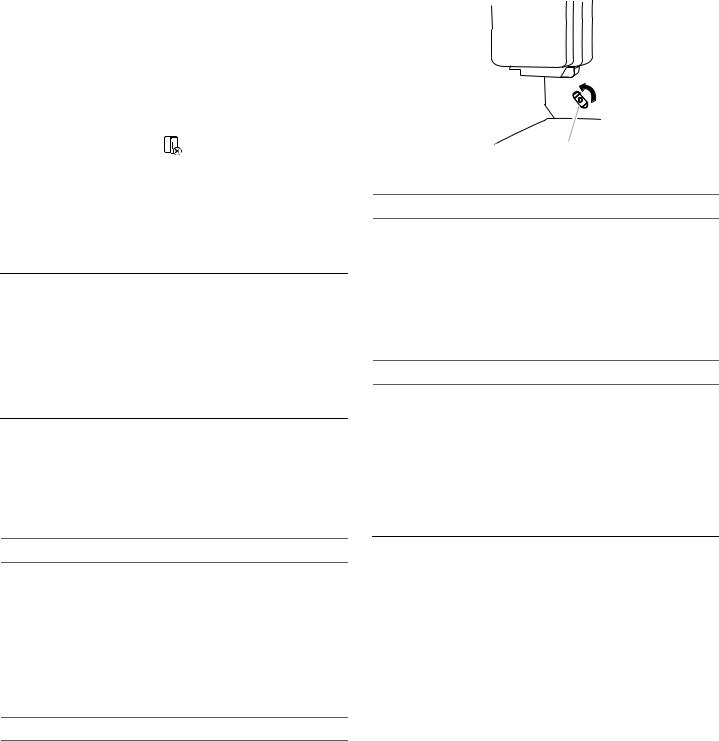
Door Ajar Alarm
The Door Ajar Alarm feature sounds an alarm when the refrigerator or freezer door is open for 5 minutes and the product cooling is turned on. The alarm will repeat every 2 minutes. Close both doors to turn it off. The feature then resets and will reactivate when either door is left open again for 5 minutes.
NOTE: To mute the audible alarm while keeping the doors open, such as while cleaning the inside of the refrigerator, press any button on the control panel. The alarm sound will be temporarily turned off, but the Door Ajar icon will still be displayed on the dispenser control panel.
Water Filter Status Light and Filter Reset
The filter reset control allows you to restart the water filter status tracking feature each time you replace the water filter. See “Water Filtration System.”
■Press and hold FILTER RESET for 3 seconds or until the “Replace Filter” light turns off.
Crisper Humidity Control
You can control the amount of humidity in the moisture-sealed crisper. Depending on your model, adjust the control to any setting between FRUIT and VEGETABLES or LOW and HIGH.
FRUIT/LOW (open) for best storage of fruits and vegetables with skins.
VEGETABLES/HIGH (closed) for best storage of fresh, leafy vegetables.
Ice Maker and Ice Storage Bin
IMPORTANT:
■Flush the water system before turning on the ice maker. See “Water and Ice Dispensers.”
■The ice maker and storage bin are located in the upper lefthand side of the refrigerator compartment.
Turning the Ice Maker On/Off
The ice maker has an automatic shutoff. When the ice maker is on, sensors will automatically stop ice production when the storage bin is full. The ice maker will remain set to ON, and ice production will resume when the bin is no longer full.
To manually turn off the ice maker, press TEMP and FAST COOL at the same time and hold for 3 seconds until the “Ice Maker Off” icon lights up. When the ice maker is set to OFF, it will stop producing ice.
Pressing and holding TEMP and FAST COOL again for 3 seconds turns on the ice maker and the “Ice Maker Off” icon disappears.
Removing and Replacing Ice Storage Bin
To Remove the Ice Storage Bin:
1.Hold the base of the storage bin and press the release button.
2.Pull out the storage bin.
To Replace the Ice Storage Bin:
IMPORTANT: It may be necessary to turn the auger driver, behind the ice bin, counterclockwise to properly align the ice bin with the auger driver. The ice storage bin must be locked in place for proper ice dispensing.
1.Slide the ice bin into the guide rails located on either side of the enclosure.
2.Push the ice bin in until resistance is felt. Raise the front slightly and push the ice bin in until an audible “click” is heard.
A
A. Auger driver
Ice Production Rate
■Allow 24 hours to produce the first batch of ice. Discard the first three batches of ice produced.
■The ice maker should produce approximately 8 to 12 batches of ice in a 24-hour period.
■To increase ice production, lower the freezer and refrigerator temperature. See “Using the Controls.” Wait 24 hours between adjustments.
NOTE: Setting the freezer to a colder temperature may make some foods, such as ice cream, harder.
Remember
■The quality of your ice will be only as good as the quality of the water supplied to your ice maker. Avoid connecting the ice maker to a softened water supply. Water softener chemicals (such as salt) can damage parts of the ice maker and lead to poor quality ice. If a softened water supply cannot be avoided, make sure the water softener is operating properly and is well maintained.
■Do not use anything sharp to break up the ice in the bin. This can cause damage to the ice bin and dispenser mechanism.
■Do not store anything in the ice storage bin.
Water and Ice Dispensers
IMPORTANT: After connecting the refrigerator to a water source or replacing the water filter, flush the water system. Use a sturdy container to depress and hold the water dispenser lever for
5 seconds, and then release it for 5 seconds. Repeat until water begins to flow. Once water begins to flow, continue depressing and releasing the dispenser lever (5 seconds on, 5 seconds off) until a total of 4 gal. (15 L) has been dispensed. This will flush air from the filter and water dispensing system and prepare the water filter for use. Additional flushing may be required in some households. As air is cleared from the system, water may spurt out of the dispenser.
NOTES:
■The dispensing system will not operate when the refrigerator door is open.
■Allow 24 hours for the refrigerator to cool down and chill water.
■Allow 24 hours to produce the first batch of ice. Discard the first three batches of ice produced.
■The display screen on the dispenser control panel will turn off automatically and enter “sleep” mode when the control buttons and dispenser levers have not been used for
2 minutes or more. While in “sleep” mode, the first press of a control button will only reactivate the display screen, without changing any settings. After reactivation, changes to any settings can then be made. If no changes are made within
2 minutes, the display will re-enter “sleep” mode.
10

The Water Dispenser
IMPORTANT: Dispense enough water every week to maintain a fresh supply.
To Dispense Water:
1.Press a sturdy glass against the water dispenser lever.
2.Remove the glass to stop dispensing.
The Ice Dispenser
Ice dispenses from the ice maker storage bin in the freezer when the dispenser lever is pressed. To turn off the ice maker, see “Ice Maker and Storage Bin.”
Your ice maker can produce both crushed and cubed ice. Before dispensing ice, select which type of ice you prefer by pressing the ICE TYPE button.
The display screen indicates which type of ice is selected.
CRUSHED CUBED
For crushed ice, cubes are crushed before being dispensed. This may cause a slight delay when dispensing crushed ice. Noise from the ice crusher is normal, and pieces of ice may vary in size. When changing from crushed to cubed, a few ounces of crushed ice will be dispensed along with the first cubes.
To Dispense Ice:
1.Make sure the desired type of ice is selected. To switch between cubed and crushed, press ICE TYPE.
WARNING
Use a sturdy glass |
ice. |
Failure to do so can result in cuts.
2.Press a sturdy glass against the ice dispenser lever. Hold the glass close to the dispenser opening so ice does not fall outside of the glass.
IMPORTANT: You do not need to apply a lot of pressure to the lever in order to activate the ice dispenser. Pressing hard will not make the ice dispense faster or in greater quantities.
3.Remove the glass to stop dispensing.
NOTE: Ice may continue to dispense for up to 10 seconds after removing the glass from the lever. The dispenser may continue to make noise for a few seconds after dispensing.
The Dispenser Light
When you use the dispenser, the light will automatically turn on. If you want the light to be on continuously, you may choose either ON or DIM. The display screen indicates which mode is selected.
ON |
DIM |
ON: Press LIGHT to turn the dispenser light on.
DIM: Press LIGHT a second time to select DIM mode. The dispenser light will remain on, but at a lower intensity.
OFF: Press LIGHT a third time to turn the dispenser light off.
The dispenser lights are LEDs that cannot be changed. If it appears that your dispenser lights are not working, see “Troubleshooting” for more information.
The Dispenser Lock
The dispenser can be turned off for easy cleaning or to avoid unintentional dispensing by small children and pets.
NOTE: The lock feature does not shut off power to the refrigerator, to the ice maker, or to the dispenser light. It simply deactivates the controls and dispenser levers. To turn off the ice maker, see “Ice Maker and Storage Bin.”
■Press and hold LOCK for 3 seconds to lock the dispenser.
■Press and hold LOCK, for 3 seconds, a second time to unlock the dispenser.
The display screen indicates when the dispenser is locked.
LOCKED UNLOCKED
Water Filtration System
The water filter is located in the upper right-hand corner of the refrigerator compartment.
Do not use with water that is microbiologically unsafe or of unknown quality without adequate disinfection before or after the system. Systems certified for cyst reduction may be used on disinfected waters that may contain filterable cysts.
Water Filter Status Light
When a water filter has been installed in the refrigerator, the water filter status lights help you know when to change your water filter.
■The water filter status icon changes will change from Normal (blue water) to Order (red waves) and “Order Filter” (orange) when 90% of the volume of water for which the filter is rated has passed through the filter OR 5 months have passed since the filter was installed.
■The “Replace Filter” (red) icon will illuminate and blink continuously during dispensing when the rated volume of water has passed through the filter OR 6 months have passed since the filter was installed. A new water filter should be installed immediately when the Replace light is illuminated.
■After 14 days at Replace Filter stage, the “Replace Filter” and “water” icons will glow (red) at all times and blink continuously during dispensing. Also, an alert chime will sound three times following dispensing.
11
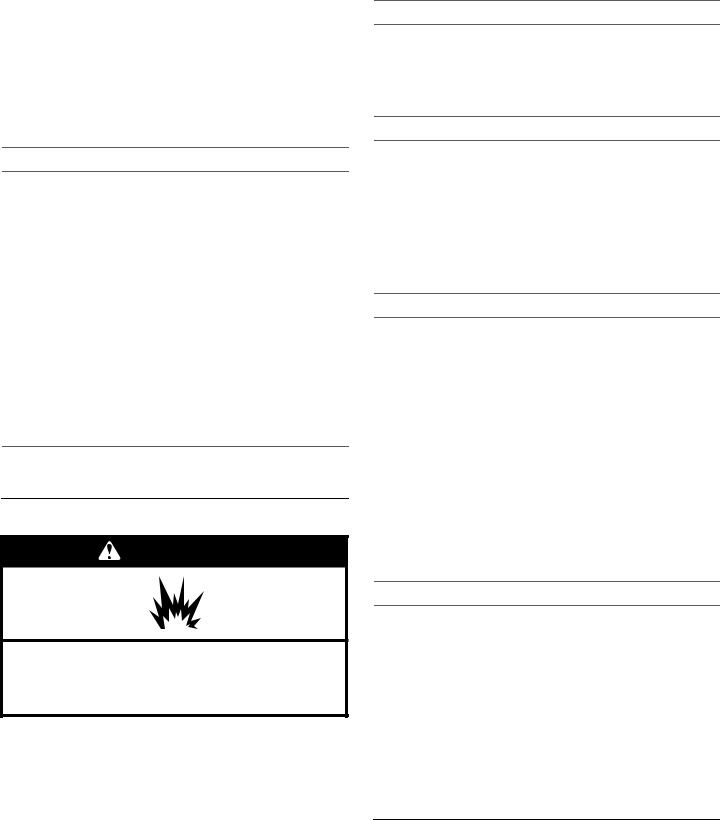
The disposable water filter should be replaced at least every
6 months. If the water flow to the water dispenser or ice maker decreases noticeably before 6 months have passed, replace the water filter more often. To change the filter, see “Water Filtration System.”
Reset Water Filter Status
After changing the water filter, reset the water filter status. On the display screen, press and hold FILTER RESET for 3 seconds. The status light will change from Replace Filter (red) to Normal (blue water) when the system is reset.
Replacing the Water Filter
To purchase a replacement water filter, model number UKF8001AXX-200, contact your dealer or call 1-800-422-9991 in the U.S.A. or 1-800-807-6777 in Canada.
IMPORTANT: Air trapped in the water system may cause water and filter to eject. Always dispense water for at least 2 minutes before removing the filter or blue bypass cap.
1.To access the filter, press upward on the ribbed section of the water filter cover.
2.Turn filter counterclockwise to remove.
3.Remove sealing label from replacement filter and insert the filter end into the filter head.
4.Turn the filter clockwise until it stops. Snap the filter cover closed.
5.Flush the water system. See “Water and Ice Dispenser.”
NOTE: The dispenser feature may be used without a water filter installed. Your water will not be filtered. If this option is chosen, replace the filter with the blue bypass cap.
REFRIGERATOR CARE
Cleaning
WARNING
Use nonflammable
Failure to do so can result in death, explosion, or fire.
Both the refrigerator and freezer sections defrost automatically. However, clean both sections about once a month to avoid odor buildup. Wipe up spills immediately.
IMPORTANT:
■Because air circulates between all compartments, any odors formed in one compartment will transfer to the other. You must thoroughly clean all compartments to eliminate odors. To avoid odor transfer and drying out of food, wrap or cover foods tightly.
■Do not use abrasive or harsh cleaners such as window sprays, scouring cleansers, flammable fluids, cleaning waxes, concentrated detergents, nail polish remover, bleaches or cleansers containing petroleum products. Do not use paper towels, scouring pads, or other harsh cleaning tools that may scratch or damage the materials.
Clean the Interior
1.Unplug refrigerator or disconnect power.
2.Using a clean sponge or soft cloth and a mild detergent in warm water, hand wash, rinse, and dry removable parts and interior surfaces thoroughly.
3.Plug in refrigerator or reconnect power.
Clean the Touch Screen Display on the Dispenser Panel
1.Make sure the refrigerator is unplugged or the power is disconnected before wiping the screen to avoid unintentionally changing the settings.
2.Mix a solution of mild detergent in warm water. Dampen a soft, lint-free cloth with the solution and gently wipe the screen.
NOTE: Do not spray or wipe liquids directly onto the screen, or over-saturate the cloth.
3.Plug in refrigerator or reconnect power.
Clean the Exterior Surfaces
1.Unplug refrigerator or disconnect power.
2.Using a clean sponge or soft cloth and a mild detergent in warm water, wash, rinse and thoroughly dry stainless steel and painted metal exteriors.
■To keep your stainless steel refrigerator looking like new and to remove minor scuffs or marks, it is suggested that you use the manufacturer’s approved Stainless Steel Cleaner and Polish, Part Number 4396095. To order the cleaner, call 1-800-422-9991 U.S.A. or 1-800-807-6777
Canada.
IMPORTANT: This cleaner is for stainless steel parts only!
Do not allow the Stainless Steel Cleaner and Polish to come into contact with any plastic parts such as the trim pieces, dispenser covers or door gaskets. If unintentional contact does occur, clean plastic part with a sponge and mild detergent in warm water. Dry thoroughly with a soft cloth.
3. Plug in refrigerator or reconnect power.
Clean the Condenser
There is no need for routine condenser cleaning in normal home operating environments. If the environment is particularly greasy or dusty, or there is significant pet traffic in the home, the condenser should be cleaned every 2 to 3 months to ensure maximum efficiency.
To clean the condenser:
1.Unplug refrigerator or disconnect power.
2.Remove the base grille.
3.Use a vacuum cleaner with a soft brush to clean the grille, the open areas behind the grille and the front surface area of the condenser.
4.Replace the base grille when finished.
5.Plug in refrigerator or reconnect power.
Changing the Light Bulb
IMPORTANT: The light bulbs in both the refrigerator and freezer compartments of your new refrigerator use LED technology. If the lights do not illuminate when the refrigerator and/or freezer door is opened, call for assistance or service. See “Warranty” for phone numbers.
1.Unplug the refrigerator or disconnect power.
2.Remove the light shield (on some models).
12
